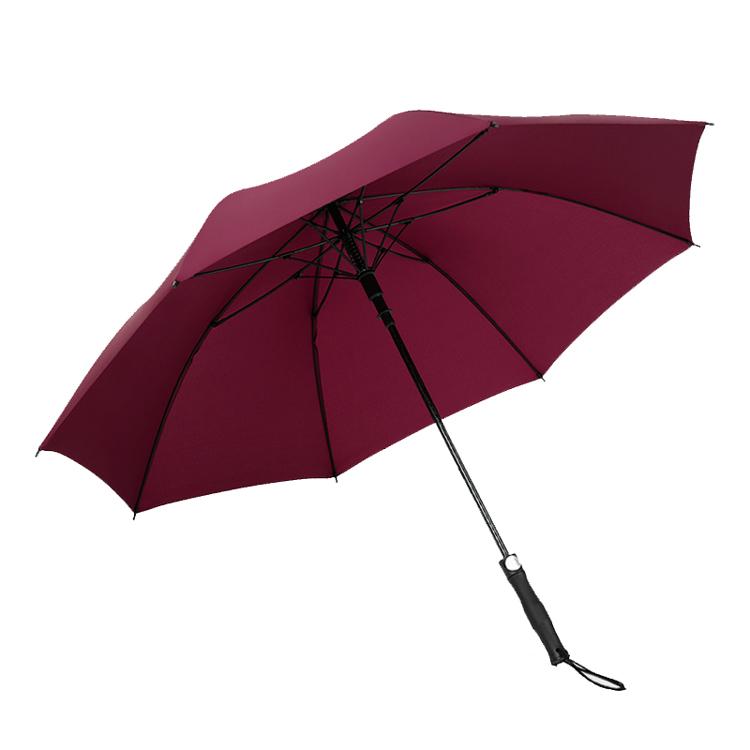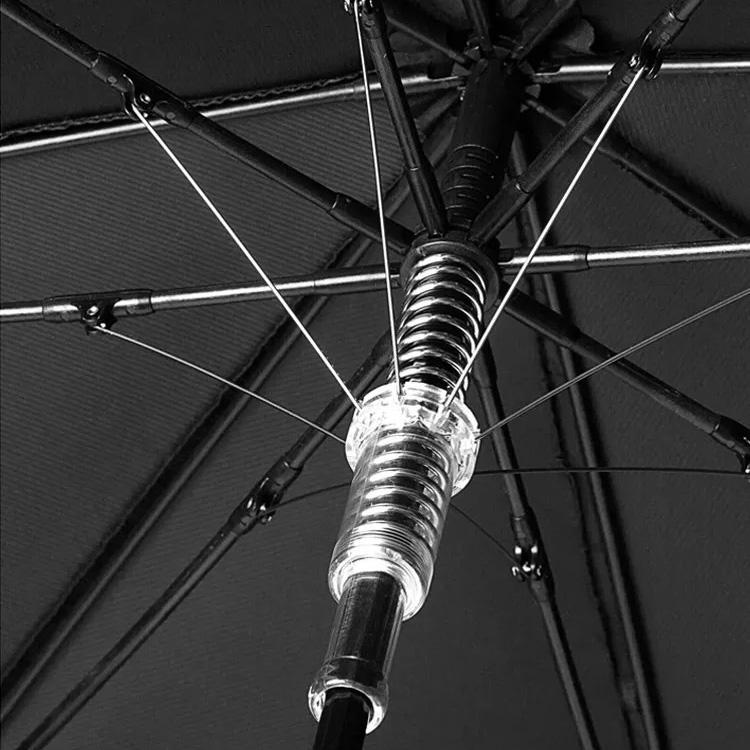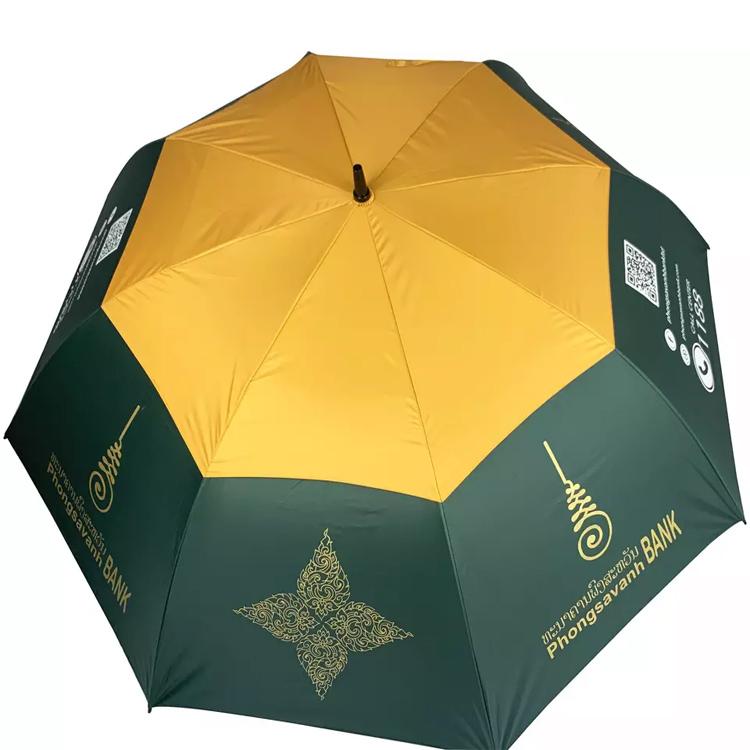How is an umbrella made of material?
How is an umbrella made of material?Materials used in umbrella production.
Umbrellas are made using a wide range of materials, each chosen for its specific qualities and performance characteristics. One of the most common materials used is nylon. Nylon is favored for its strength, water resistance, and durability. It is lightweight and can withstand harsh weather conditions, making it an ideal choice for umbrellas.

Another popular material used in umbrella production is polyester. Polyester is known for its excellent water repellency and resistance to UV radiation. It is also resistant to stretching, shrinking, and wrinkling, ensuring that the umbrella maintains its shape and appearance over time.
Pongee fabric is another material widely used in umbrella manufacturing. Pongee is a type of silk or cotton fabric that is tightly woven, making it highly durable and resistant to tearing. It provides excellent protection against the rain and is often used in high-quality umbrellas.
Step-by-step process of making an umbrella
The process of making an umbrella involves several intricate steps that require precision and attention to detail. It starts with the selection of the appropriate fabric, which is then cut into panels of the desired size and shape. These panels are then sewn together using specialized machines, ensuring a tight and secure fit.
The next step involves the assembly of the umbrella frame. The frame is typically made of lightweight materials such as aluminum or fiberglass, which provide strength and flexibility. The frame is carefully constructed, with each rib and strut precisely positioned to ensure proper tension and stability.
Once the frame is complete, the fabric panels are attached to the frame using a combination of stitching and adhesive. This ensures that the fabric is securely fastened and will withstand the rigors of everyday use. The final step involves adding the finishing touches, such as the handle and the opening mechanism, which are designed to be both functional and aesthetically pleasing.

Importance of quality materials in umbrella construction
The quality of the materials used in umbrella construction is of utmost importance. Inferior materials can result in umbrellas that are not only less durable but also less effective in providing protection from the elements. High-quality materials, on the other hand, ensure that the umbrella is able to withstand wind, rain, and sun exposure, providing long-lasting performance.
When it comes to the fabric, choosing a material that is water-resistant and UV resistant is crucial. Water-resistant fabrics prevent water from seeping through, keeping the user dry even in heavy rain. UV-resistant fabrics protect against harmful ultraviolet rays, reducing the risk of sunburn and skin damage.
The frame material also plays a significant role in the umbrella’s overall durability and performance. Lightweight yet strong materials, such as fiberglass or aluminum, offer the perfect balance of strength and flexibility. This allows the umbrella to withstand strong winds without easily bending or breaking.
Different types of umbrella fabrics
There are several types of fabrics commonly used in umbrella production, each with its own unique properties and advantages. One popular fabric is microfiber, which is known for its excellent water repellency and quick-drying capabilities. Microfiber is also lightweight and easy to clean, making it a practical choice for umbrellas.
Another common fabric used in umbrella manufacturing is Teflon-coated fabric. Teflon coating provides an extra layer of protection against water, ensuring that the umbrella remains dry even in heavy downpours. It also makes the fabric resistant to stains and dirt, making it easier to clean and maintain.
For those who prioritize environmental sustainability, eco-friendly fabrics such as recycled polyester or organic cotton are becoming increasingly popular. These fabrics are made from recycled materials or grown without the use of harmful chemicals, reducing the environmental impact of umbrella production.
Innovations in umbrella design and materials
As technology continues to advance, so does the design and materials used in umbrella manufacturing. One notable innovation is the introduction of windproof umbrellas. These umbrellas are designed to withstand strong winds without inverting or breaking. They often feature reinforced frames and flexible materials that can withstand high wind speeds.
Another innovation is the use of transparent materials, such as clear PVC or polycarbonate, for the umbrella canopy. Transparent umbrellas provide excellent visibility, allowing users to stay protected from the rain while still being able to see their surroundings. They are also a stylish alternative to traditional opaque umbrellas.
Additionally, some umbrellas now come with built-in technology, such as LED lights or Bluetooth connectivity. LED lights provide additional visibility during nighttime use, while Bluetooth connectivity allows users to connect their umbrella to their smartphone for added convenience and functionality.
Factors to consider when choosing an umbrella
When choosing an umbrella, there are several factors to consider to ensure that you make the right choice for your needs. First and foremost, consider the size and weight of the umbrella. A compact and lightweight umbrella is ideal for travel, while a larger umbrella provides more coverage and protection.
You should also consider the level of durability you require. If you live in an area with frequent rain or strong winds, opt for an umbrella with a sturdy frame and a durable fabric. Additionally, consider the ease of use, including the opening and closing mechanism and the handle design. Ergonomic handles provide a comfortable grip, making it easier to hold the umbrella for extended periods.
Lastly, consider the style and design of the umbrella. Umbrellas come in a wide range of colors, patterns, and designs, allowing you to express your personal style while staying protected from the rain. Whether you prefer a classic black umbrella or a vibrant patterned one, there is an umbrella out there to suit your taste.
Umbrella care and maintenance
To ensure that your umbrella lasts as long as possible, proper care and maintenance are essential. After each use, it is important to fully open the umbrella and allow it to dry completely before folding it back up. This helps prevent the growth of mold and mildew, which can deteriorate the fabric and weaken the frame.
If your umbrella becomes dirty, gently wipe it clean with a soft cloth or sponge and mild soap. Avoid using harsh chemicals or abrasive materials, as they can damage the fabric or remove any protective coatings. It is also recommended to store the umbrella in a dry place when not in use, preferably in a protective case or sleeve.
Regularly inspect your umbrella for any signs of damage or wear. Check the frame for any bent or broken ribs and ensure that the fabric is still intact and free from tears. If you notice any issues, it is best to have the umbrella repaired or replaced to maintain its functionality and effectiveness.
Sustainable and eco-friendly umbrella options
In recent years, there has been a growing demand for sustainable and eco-friendly products, including umbrellas. Many manufacturers are now offering umbrellas made from recycled materials or using eco-friendly production methods. These umbrellas are not only better for the environment but also often of high quality and durability.
Some umbrellas are made from recycled polyester, which is created by processing discarded plastic bottles. These umbrellas help reduce plastic waste and promote the use of recycled materials. Additionally, there are umbrellas made from organic cotton, which is grown without the use of harmful pesticides or genetically modified organisms.
Another sustainable option is to choose an umbrella that is designed to last a lifetime. These umbrellas are made from high-quality materials and are built to withstand the test of time. By investing in a durable umbrella, you can reduce the need for frequent replacements, thus minimizing waste.
Conclusion
The creation of an umbrella is a blend of artistry, craftsmanship, and technological innovation. From the careful selection of materials to the precise assembly of each component, every step in the manufacturing process is crucial to ensuring a high-quality and functional umbrella.
By understanding the different materials used in umbrella production, the step-by-step process involved, and the importance of quality and design, you can make an informed decision when choosing an umbrella that suits your needs.
Whether you prioritize durability, style, or sustainability, there is an umbrella out there that will provide you with the perfect balance of form and function. So, the next time you shield yourself from the rain under your trusty umbrella, take a moment to appreciate the craftsmanship and expertise that went into its creation.
Umbrella manufacturing process
Umbrella Manufacturing Process
Are you curious about how umbrellas are made? In this article, we will take you behind the scenes of the umbrella manufacturing process, uncovering the fascinating journey from raw materials to the finished product. Whether you’re a fan of classic black umbrellas or love the vibrant patterns of a decorative one, understanding how they are made adds a whole new level of appreciation for this essential accessory.
History of Umbrellas
Umbrellas have been used for centuries to shield individuals from the rain and sun. The concept of a portable canopy dates back to ancient civilizations, where it was used by royalty and nobility as a symbol of status. In ancient Egypt, umbrellas were made from palm leaves, while in ancient China, they were crafted from silk and bamboo. Over time, umbrellas evolved, with waterproof materials and collapsible frames being introduced. Today, umbrellas are not only functional but also fashionable, reflecting various styles and designs.
Types of Umbrellas
There are various types of umbrellas available in the market, each designed to cater to specific needs. The most common types include compact umbrellas, golf umbrellas, beach umbrellas, and patio umbrellas. Compact umbrellas are lightweight and easily foldable, making them convenient for everyday use. Golf umbrellas, on the other hand, have a larger canopy to provide ample coverage on the golf course. Beach umbrellas are designed to withstand wind and provide shade on sandy shores, while patio umbrellas are used to create shaded areas in outdoor spaces. With such a wide range of options, there is an umbrella for every occasion.
Materials Used in Umbrella Manufacturing
The quality of an umbrella depends on the materials used in its construction. The frame, canopy fabric, and handle are the key components that determine an umbrella’s durability and functionality. The frame is usually made of materials like steel, fiberglass, or aluminum, which provide strength and stability. The canopy fabric is typically made from polyester or nylon, which are water-resistant and quick-drying. The handle can be crafted from various materials, including wood, plastic, or rubber, depending on the desired aesthetic and comfort.
The Umbrella Manufacturing Process
The umbrella manufacturing process involves several intricate steps that ensure the creation of a high-quality product. Let’s take a closer look at each stage:
1. Cutting and Preparing the Fabric
The first step in umbrella production is cutting and preparing the fabric panels. The canopy fabric is carefully measured and cut into individual panels, which will later be sewn together. Precision is crucial to ensure that the panels fit seamlessly and create a smooth, taut canopy. Once the fabric panels are cut, they are organized and prepared for the next stage of the manufacturing process.
2. Sewing the Canopy
After the fabric panels have been cut, they are sewn together to create the umbrella’s canopy. Skilled seamstresses use specialized sewing machines to stitch the panels together, ensuring that the seams are strong and durable. The sewing process requires precision and attention to detail, as any inconsistencies may compromise the integrity of the umbrella. Once the canopy is sewn, it is inspected for quality assurance before proceeding to the next stage.
3. Assembling the Frame
Simultaneously, the frame of the umbrella is being assembled. The frame consists of several components, including ribs, stretchers, and a central shaft. These parts are carefully connected to create a sturdy and collapsible structure. The ribs, which are responsible for supporting the canopy, are attached to the stretchers, which provide tension and stability. The central shaft, often made of steel or aluminum, holds the entire frame together. Skilled craftsmen ensure that all parts fit precisely, allowing the umbrella to open and close smoothly.
4. Attaching the Canopy to the Frame
Once the canopy and frame are ready, they are brought together for the final assembly. The canopy is attached to the frame, with the fabric panels secured to the ribs using stitching or adhesive. This process requires careful alignment and attention to detail to ensure that the canopy is evenly distributed and properly tensioned. The attachment of the canopy to the frame is a critical step in the manufacturing process, as it determines the umbrella’s overall appearance and functionality.
5. Adding Finishing Touches
After the canopy is attached to the frame, the umbrella goes through a series of finishing touches. These include adding a handle, attaching a strap for easy carrying, and incorporating any additional features like a tilt mechanism or wind vents. The handle is carefully chosen for comfort and aesthetics, with various designs and materials available. The strap provides convenience for users, allowing them to secure the umbrella when not in use. Each finishing touch is meticulously executed to enhance the umbrella’s usability and visual appeal.
Quality Control in Umbrella Manufacturing
To ensure the production of high-quality umbrellas, manufacturers implement strict quality control measures. Throughout the manufacturing process, each stage is carefully inspected for any defects or imperfections. Skilled technicians examine the fabric, frame components, and finished umbrellas to ensure that they meet the brand’s standards. This rigorous quality control process guarantees that customers receive umbrellas that are reliable, durable, and built to withstand the elements.
Innovations in Umbrella Manufacturing
As technology advances, so does the umbrella manufacturing industry. Innovations have led to the development of new materials, such as carbon fiber, which offer superior strength and lightweight properties. Additionally, automatic open and close mechanisms have become increasingly popular, providing convenience and ease of use. Some umbrellas even incorporate advanced features like UV protection and wind-resistant designs. These innovations not only enhance the functionality of umbrellas but also contribute to their overall durability and performance.
Sustainability in Umbrella Manufacturing
With growing environmental concerns, umbrella manufacturers are making efforts to incorporate sustainable practices into their production processes. Eco-friendly materials, such as recycled polyester, are being used in the fabrication of canopy fabrics. Additionally, some manufacturers have implemented recycling programs, allowing customers to return their old umbrellas for proper disposal or refurbishment. By adopting sustainable practices, the umbrella industry is taking steps towards reducing waste and minimizing its environmental impact.
Popular Umbrella Brands and Their Manufacturing Processes
Several renowned umbrella brands have gained recognition for their quality craftsmanship and innovative designs. Each brand has its unique manufacturing process, often incorporating proprietary techniques and materials. For example, Brand A prides itself on handcrafted umbrellas, with skilled artisans meticulously assembling each component. On the other hand, Brand B focuses on advanced technology, utilizing cutting-edge machinery to ensure precision and efficiency. Understanding the manufacturing processes of popular brands can help consumers make informed decisions when purchasing their next umbrella.
Conclusion
The umbrella manufacturing process is a combination of artistry and precision. From the selection of sturdy frames to the application of water-resistant fabric, each step plays a crucial role in creating a high-quality umbrella. Skilled craftsmen and technicians work diligently to ensure that every detail is executed flawlessly, resulting in a product that is both functional and aesthetically pleasing. With ongoing innovations and sustainable practices, the umbrella industry continues to evolve, offering consumers a wide range of options to suit their needs and preferences. So the next time you open your umbrella, take a moment to appreciate the craftsmanship that went into creating this indispensable accessory.

